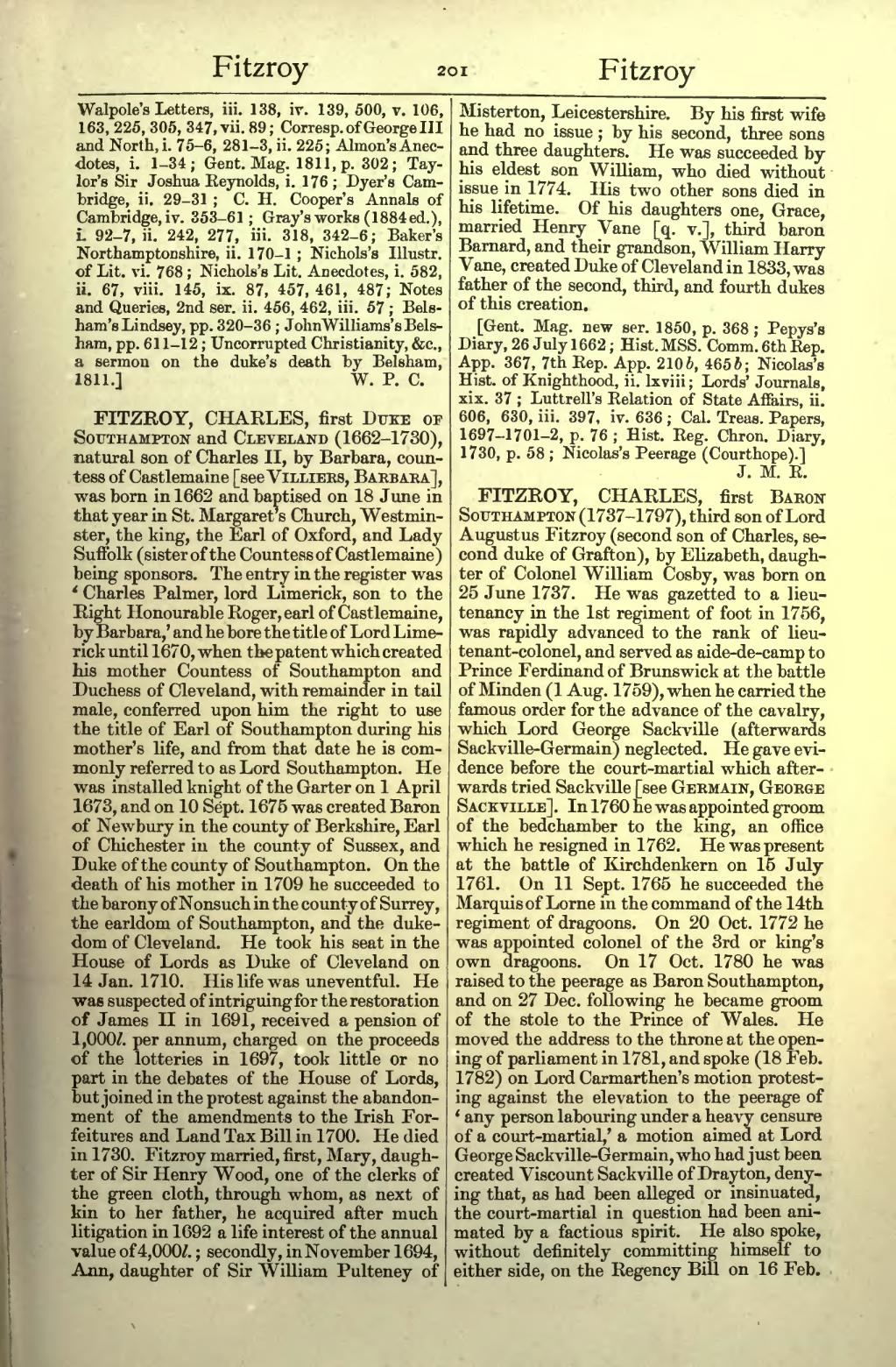Walpole's Letters, iii. 138, iv. 139, 500, v. 106, 163, 225, 305, 347, vii. 89; Corresp. of George III and North, i. 75-6, 281-3, ii. 225; Almon's Anecdotes, i. 1-34; Gent. Mag. 1811, p. 302; Taylor's Sir Joshua Reynolds, i. 176 ; Dyer's Cambridge, ii. 29-31 ; C. H. Cooper's Annals of Cambridge, iv. 353-61; Gray's works (1884 ed.), i. 92-7, ii. 242, 277, iii. 318, 342-6; Baker's Northamptonshire, ii. 170-1 ; Nichols's Illustr. of Lit. vi. 768 ; Nichols's Lit. Anecdotes, i. 582, ii. 67, viii. 145, ix. 87, 457, 461, 487; Notes and Queries, 2nd ser. ii. 456, 462, iii. 57 ; Belsham's Lindsey, pp. 320-36 ; John Williams's Belsham, pp. 611-12 ; Uncorrupted Christianity, &c., a sermon on the duke's death by Belsham, 1811.]
FITZROY, CHARLES, first Duke of Southampton and Cleveland (1662–1730), natural son of Charles II, by Barbara, countess of Castlemaine [see Villiers, Barbara], was born in 1662 and baptised on 18 June in that year in St. Margaret's Church, Westminster, the king, the Earl of Oxford, and Lady Suffolk (sister of the Countess of Castlemaine) being sponsors. The entry in the register was ‘Charles Palmer, lord Limerick, son to the Right Honourable Roger, earl of Castlemaine, by Barbara,’ and he bore the title of Lord Limerick until 1670, when the patent which created his mother Countess of Southampton and Duchess of Cleveland, with remainder in tail male, conferred upon him the right to use the title of Earl of Southampton during his mother's life, and from that date he is commonly referred to as Lord Southampton. He was installed knight of the Garter on 1 April 1673, and on 10 Sept. 1675 was created Baron of Newbury in the county of Berkshire, Earl of Chichester in the county of Sussex, and Duke of the county of Southampton. On the death of his mother in 1709 he succeeded to the barony of Nonsuch in the county of Surrey, the earldom of Southampton, and the dukedom of Cleveland. He took his seat in the House of Lords as Duke of Cleveland on 14 Jan. 1710. His life was uneventful. He was suspected of intriguing for the restoration of James II in 1691, received a pension of 1,000l. per annum, charged on the proceeds of the lotteries in 1697, took little or no part in the debates of the House of Lords, but joined in the protest against the abandonment of the amendments to the Irish Forfeitures and Land Tax Bill in 1700. He died in 1730. Fitzroy married, first, Mary, daughter of Sir Henry Wood, one of the clerks of the green cloth, through whom, as next of kin to her father, he acquired after much litigation in 1692 a life interest of the annual value of 4,000l.; secondly, in November 1694, Ann, daughter of Sir William Pulteney of Misterton, Leicestershire. By his first wife he had no issue; by his second, three sons and three daughters. His eldest son and successor, William, died without issue in 1774. Two other sons died in his lifetime. Of his daughters, Grace married Henry Vane [q. v.], third baron Barnard, and their grandson, William Harry Vane, created Duke of Cleveland in 1833, was father of the second, third, and fourth dukes of this creation.
[Gent. Mag. new ser. 1850, p. 368; Pepys's Diary, 26 July 1662; Hist. MSS. Comm. 6th Rep. App. 367, 7th Rep. App. 210 b, 465 b; Nicolas's Knighthood, ii. lxviii; Lords' Journals, xix. 37; Luttrell's Relation, ii. 606, 630, iii. 397, iv. 636; Cal. Treas. Papers, 1697–1701–2, p. 76; Hist. Reg. Chron. Diary, 1730, p. 58; Nicolas's Peerage (Courthope).]
FITZROY, CHARLES, first Baron Southampton (1737–1797), third son of Lord Augustus Fitzroy (second son of Charles, second duke of Grafton), by Elizabeth, daughter of Colonel William Cosby, was born on 25 June 1737. He was gazetted to a lieutenancy in the 1st regiment of foot in 1756, was rapidly advanced to the rank of lieutenant-colonel, and served as aide-de-camp to Prince Ferdinand of Brunswick at the battle of Minden (1 Aug. 1759), when he carried the famous order for the advance of the cavalry, which Lord George Sackville (afterwards Sackville-Germain) neglected. He gave evidence before the court-martial on Sackville [see Germain, George Sackville]. He was M.P. for Oxford 1759–61, for Bury St. Edmunds 1761–74, and for Thetford 1774–80. In 1760 he was appointed groom of the bedchamber to the king, an office which he resigned in 1762. He was present at the battle of Kirchdenkern on 15 July 1761. On 11 Sept. 1765 he succeeded the Marquis of Lorne in the command of the 14th regiment of dragoons. On 20 Oct. 1772 he was appointed colonel of the 3rd or king's own dragoons. On 17 Oct. 1780 he was raised to the peerage as Baron Southampton, and on 27 Dec. following he became groom of the stole to the Prince of Wales. He moved the address to the throne at the opening of parliament in 1781, and spoke (18 Feb. 1782) on Lord Carmarthen's motion protesting against the elevation to the peerage of ‘any person labouring under a heavy censure of a court-martial,’ a motion aimed at Lord George Sackville-Germain, who had just been created Viscount Sackville of Drayton, denying that, as had been alleged or insinuated, the court-martial in question had been animated by a factious spirit. He also spoke, without definitely committing himself to either side, on the Regency Bill on 16 Feb.
